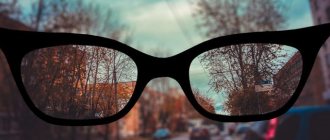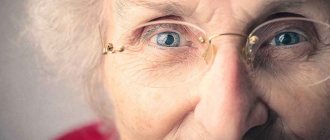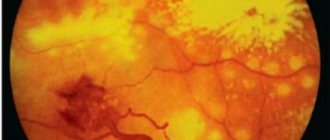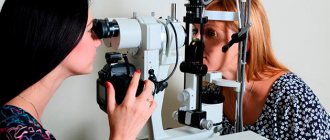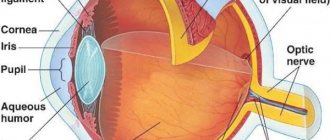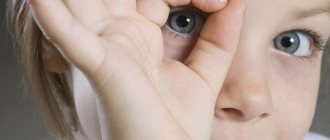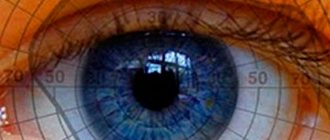Myopia is a serious problem that is associated not only with deterioration of distance vision, but also with an increased risk of complications (retinal dystrophy and detachment).
Myopic people find it difficult to carry out professional activities and even simple household chores. Due to decreased visual acuity, it is not easy for the patient to drive a car, read signs, information boards. It is difficult for a nearsighted person with a high degree of disease to see a familiar face even at a distance of one or two meters. Obviously, myopia is a disadvantage that greatly disables the patient and interferes with normal life.
Why is vision impaired?
With myopia, light rays are refracted in the transparent media of the eye in such a way that the image is focused in front of the retina. This is facilitated not only by the structural features of the lens and cornea, but also by the elongated anterior-posterior axis of the eye.
Correction is carried out using minus lenses. Their refractive power depends on the degree of the disease:
- up to -3 D – weak,
- from -3 to -6 D – average,
- above -6 D – high
Presbyopia
Presbyopia is a type of farsightedness. In this case, the disease is associated with age-related changes in the lens, as a result of which the functioning of the accommodative system is disrupted. Another name for presbyopia is short arm disease. This is due to the fact that with the development of presbyopia, the patient gradually begins to move the text further and further from the eyes. as a result, even at the maximum distance from the eyes, a person cannot read the text.
As the accommodative capabilities of the lens decrease, the patient is no longer able to distinguish letters in a book, on a medicine package, or on a telephone. Sometimes presbyopia is combined with classic farsightedness or myopia. An ophthalmologist should take this fact into account when selecting glasses for vision correction.
Correction methods
Modern ophthalmology and the Eye Surgery Center present a wide selection of means to solve the problem of myopia:
Contact correction
In the contact correction department of the I. Medvedev ophthalmological clinic, a complete vision diagnosis is performed with the selection of the optimal option for glasses or contact lenses. If necessary, the patient is trained, and recommendations are given on wearing and caring for the products. Specialists at the Eye Surgery Center work only with proven manufacturers of high-quality ophthalmological products.
Microsurgical treatment
LASIK surgery and its modifications allow you to change the curvature of the cornea, and therefore its refractive power. Short-term exposure to laser radiation on the middle layers of the cornea allows you to achieve an optimal result and change the refractive ability of this structure so that the image is focused strictly on the retina.
To receive individual recommendations from an ophthalmologist, you must make an appointment at the Eye Surgery Center by calling: +7, (499) 246-32-28.
Does visual acuity depend on the minus of vision (for myopic people?)
Myopia (myopia) is an eye disease in which a person sees close objects well, but objects located at a far distance from him are unclear and blurry. What does visual acuity depend on in this case? Is there a connection between it and the lack of vision?
Before answering the questions above, you need to understand what is meant by visual acuity. In simple terms, this is the vision of a person without glasses or contact lenses.
Some people confuse this parameter with the refraction of the eye. For example, you can hear from them something like: “My vision is either minus 3 or 0.3, I don’t even know for sure.” Although in this case the clinical refraction of the eye is myopia of 3 diopters, and visual acuity (an indicator of eye vigilance) is 0.3. As a rule, the higher the refraction, the worse the indicator of eye vigilance, but there is no direct connection here.
In order to describe the condition of the eyes, the ophthalmologist always specifies three important parameters - the index of vigilance of the eyes without glasses correction, refraction and the index of vigilance with maximum correction, i.e. with lenses that correspond to the refraction. The latter must show whether the patient has any concomitant eye diseases, since if it is only a matter of spectacle optics, then the vision in it should be ideal, i.e. 100%. If no lenses give such an effect, then it is concluded that the patient has some kind of disease. Therefore, the indicator of eye vigilance depends, among other things, on the presence/absence of eye diseases in a person. In addition, the size of the pupil, the transparency of the cornea, the condition of the retina, optic nerve, lens and other parameters play a role here.
Many patients who suffer from myopia are concerned about the following questions: is it necessary to wear corrective glasses and will their eyes see worse after using them? Of course, this should be decided individually with an ophthalmologist. However, we note that wearing glasses correction helps to stop the progression of myopia, but the indicator of eye vigilance may fall when wearing them. It makes sense to wear glasses when a person cannot see well without them. If this is your case, there is no need to suffer - it is better to immediately contact an ophthalmologist, who will not only write you a prescription for eyeglasses or contact lenses, but will also inform you about possible eye diseases.
For myopia, the doctor may offer (depending on the degree of the disease) drug treatment (for example, Taufon eye drops, nicotinic or ascorbic acid, calcium gluconate), special eye exercises, physiotherapeutic procedures (phonophoresis, electrophoresis, electrical or laser stimulation of the ciliary muscles) or surgery (laser surgery).
MagazinLinz.ru team
Foods that help improve vision
- First we will have blueberries. This is the most famous product for maintaining vision. In the summer you need to eat at least 10 glasses of this wonderful berry.
- Eggs contain lutein and amino acids that prevent the occurrence of cataracts.
- Be sure to include fish in your diet. Almost every type of it contains fatty acids, which have a positive effect not only on the eyes, but also on all organs.
- Greens (arugula, spinach and parsley). These products have special components that protect the retina from the negative effects of sunlight.
- Sesame, nuts and seeds are those products that contain a considerable amount of zinc. These products are suitable for those who have a computer-related job or those who simply spend a lot of time in front of a monitor.
- Meat, especially beef, is also rich in zinc.
- Carrots, sweet potatoes, mangoes, persimmons, apricots - they contain carotene, which protects the eyes from dryness. Freshly squeezed carrot juice is especially useful. It is best to cook it yourself.
- Eating these products will not save you from existing serious diseases, but will help prevent the development of new ones.
How can you cure myopia forever?
The most effective way to treat myopia is laser correction. Surgery is prescribed for adult patients. It is contraindicated before the age of 18, since the visual organs are still in the process of formation. The results of the operation may subsequently change. To date, several techniques have been developed by which laser vision correction is carried out. The choice of a specific method is determined by the medical indications and financial capabilities of the clinic client. The essence of any laser operation comes down to three stages:
- Formation of a flap from the superficial layer of the cornea. It is either moved to the side or completely removed depending on the technique (PRK, LASEK, LASIK).
- Evaporation of corneal tissue with a laser beam. This procedure lasts 1-2 minutes until the cornea takes the correct shape.
- Returning the corneal flap to its original place and installing a bandage lens on the operated area of the eye.
Diagnostics
Only an ophthalmologist can identify the disease, determine the degree of myopia and choose the most appropriate treatment method for a given case.
Diagnosis of myopia requires the following studies:
- testing distance visual acuity without glasses;
- determination of refraction (refraction) of the eyes and the degree of myopia;
- choosing the right lenses;
- measuring eye length in an ultrasound room;
- measuring the thickness of the cornea at various points;
- examination of the fundus (will allow the doctor to assess the condition of the retina, blood vessels, optic nerve of each eye);
- choosing the right lenses;
- selection of correction and treatment method.
Lack of myopia correction or incorrectly selected glasses (lenses) can lead to rapid deterioration of vision and the development of progressive myopia.
Prevention
Any disease is easier to prevent than to treat. Prevention of myopia involves the following measures:
- Adjusting the lighting mode.
Visual stress is allowed only in good lighting using overhead light, a table lamp 60-100 W. Do not work under fluorescent lamps. - Compliance with the regime of visual and physical activity.
It is recommended to alternate visual strain with active, active rest: with myopia up to 3 diopters, physical activity is not limited; over 3 diopters, lifting weights, jumping and some types of competitions are prohibited. - Gymnastics for the eyes
(every 20-30 minutes). - Correct vision correction
prescribed by an ophthalmologist. - Training of muscles
, the tension of which leads to the growth of myopia (laser stimulation, video-computer vision correction, eye drops, special courses of eye gymnastics). - Ophthalmological diagnostics
: ultrasound measurement of the longitudinal size of the eye (once every six months). - General strengthening measures
(swimming, massage of the collar area, contrast shower) on the recommendation of an ophthalmologist. - Complete balanced nutrition
.
Vision Test Chart
You can ask your ophthalmologist for this device to test your vision. How can we check our eyesight at home? The table is a regular set of block letters of different sizes. Eyes with 100% vision perfectly perceive the line V=1.0. The table also has a column “D=…” in the left corner, which indicates the distance from which you need to look at the letters. The distance is calculated for a person with 100% vision. The ophthalmologist's vision test chart looks similar. The only difference is that you see it not on a monitor screen, but on paper. It is also recommended to print it at home to get a more accurate result.
How to wear optical products for myopia
It is necessary to constantly wear optics for myopia only at a high degree (−6 diopters or more), when a person sees poorly even at arm's length. With an average degree, characterized by a deviation from −3 to −6D, the distance of “good vision” is about 30 cm. Glasses are needed almost constantly. They can be removed when reading or working at the computer. A weak form of myopia - from −0.2 to −3 diopters — practically does not need correction. Optics are mainly used by drivers when they are driving a car.
Surgical treatment of myopia
For severe myopia, surgery to install phakic lenses may be prescribed. They are practically no different from conventional contact optics, but are implanted directly under the cornea while preserving the natural lens.
There is a more radical way to combat myopia - replacing the natural lens with an artificial one - an intraocular lens (IOL). Typically, a similar procedure is prescribed for cataracts. There may be other indications. This treatment method is very effective and in some cases is the only way to preserve the patient’s vision.
Modern IOLs can provide the clearest possible images. Such lenses are multifocal, toric, and aspheric. The most expensive models are equipped with filters to protect against ultraviolet radiation. The surgery is performed on an outpatient basis, but only on one eye. The second one is operated on in about six months.
Complications
If myopia is not treated in a timely manner or corrected correctly, it may progress. Complications may occur such as:
- formation of scleral staphylomas
(protrusion); - retinal dystrophy;
- hemorrhages on the retina and vitreous body;
- cataract;
- retinal disinsertion.
Cataract as a consequence of advanced myopia
Complications due to myopia can occur at any age. In addition, destructive processes on the retina sometimes develop after surgical treatment of myopia due to the altered shape of the eye, which cannot be corrected.
In case of myopia (especially high degree), it is necessary to undergo regular examinations by an ophthalmologist, which will allow you to monitor the condition of the retina and make it possible to detect tears, holes, and thinning in time.
Dispute resolution - is treatment necessary?
There are two opposing opinions regarding the need for treatment if a person’s vision is minus 1. Some people believe that it is possible to live with such vision without any problems, and if treatment is started, then the body will not personally struggle with myopia.
Others believe that it is necessary, even in the early stages of the problem, to carry out treatment and either prescribe glasses, or undergo therapy, and in some cases even undergo surgery. These opinions are opposite, who is right?
Treatment methods for accommodative and anatomical myopia
If you are still tormented by the thought that you have minus 1 vision, what does such a statement mean, is it dangerous, then we hasten to reward you with irreplaceable information with which you will no longer have such questions.
Anatomical myopia
In this case, the eye is extended in the anterior-posterior direction, and the focus is in front of the retina. Accommodative muscles work normally. If after a course of therapeutic exercises (for example, retracting the eyes deep into the sockets) vision has fallen below “minus 1,” then additional manipulations need to be carried out, including surgical intervention.
Accommodative myopia
The eyes are not extended, and vision is “minus 1”. What does this symptom mean? In this case, there is weakness of the accommodative muscles. To improve vision, you need to pay attention to the accommodative muscles and train them. For this purpose, a system of eye gymnastics, special devices and drug therapy were developed. In this case, glasses are not prescribed, as they will cause the muscles to stop working. Accommodative myopia often develops due to spasm of the eye muscles.
Ultrasound examination will help determine the type of myopia. This way you can find out how long the eye is. If after treatment the vision is still “minus 1”, then this already indicates the presence of true myopia, which means glasses are needed. The downside of glasses is that they prevent your eyes from exercising in one way or another. However, properly selected glasses (less than minus 1) will allow the eye muscles to work. The ability to see needs to be trained and maintained.
